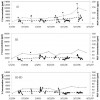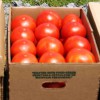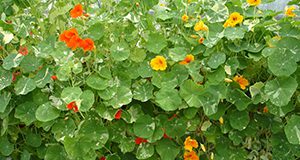Powdery mildew, which is caused by the fungus Leveillua rutae (syn. Oidiopsis haplophylli) on nasturtium (Tropaeolum majus L.), was found in southwest Florida for the first time in 2015 (Fayette et al. 2016). This two-page fact sheet describes the pathogen, its symptoms, and how to manage it. Written by Pamela D. Roberts, Katherine E. Hendricks, Francesco Di Gioia, Joubert Fayette, and Monica Ozores-Hampton and published by the Plant Pathology Department.
http://edis.ifas.ufl.edu/pp335
Tag: Gregory S. Hendricks
Factors Affecting Phosphorus Leaching and Groundwater Concentrations for the Plasticulture Vegetable-Production System
 Although Best Management Practices (BMPs) have been developed to reduce the loss of nutrients, like P, to the environment, limited information exists on the main factors that control P loss to Florida groundwater. For example, while it is generally accepted that both irrigation and fertilizer P impact groundwater P, growers often ask if controlling one is more advantageous than the other in their efforts to reduce P leaching. There exists no easy tool to link fertilizer P input and other factors to groundwater P concentration. This 5-page fact sheet uses long-term data (six growing seasons) from a farm in Immokalee, Florida, to explain the effects of soil and agronomic factors, along with seasonal rainfall, on groundwater P. From these factors are derived simple equations to predict groundwater P concentrations. Written by Sanjay Shukla, Gregory S. Hendricks, Thomas A. Obreza, and Willie Harris, and published by the UF Department of Agricultural and Biological Engineering, August 2014.
Although Best Management Practices (BMPs) have been developed to reduce the loss of nutrients, like P, to the environment, limited information exists on the main factors that control P loss to Florida groundwater. For example, while it is generally accepted that both irrigation and fertilizer P impact groundwater P, growers often ask if controlling one is more advantageous than the other in their efforts to reduce P leaching. There exists no easy tool to link fertilizer P input and other factors to groundwater P concentration. This 5-page fact sheet uses long-term data (six growing seasons) from a farm in Immokalee, Florida, to explain the effects of soil and agronomic factors, along with seasonal rainfall, on groundwater P. From these factors are derived simple equations to predict groundwater P concentrations. Written by Sanjay Shukla, Gregory S. Hendricks, Thomas A. Obreza, and Willie Harris, and published by the UF Department of Agricultural and Biological Engineering, August 2014.
http://edis.ifas.ufl.edu/ae507
Interpreting Dye Test Results for Improved Drip Irrigation Management for the Mulched Vegetable-Production Systems in South Florida
 With Florida’s water withdrawals expected to increase by 30% from 2000 to 2030, South Florida vegetable producers are conserving water by converting traditional seepage irrigation systems to drip irrigation, which can have up to 90% efficiency when used effectively. Dye tests can provide important information for implementing a proper drip irrigation management program. This 6-page fact sheet was written by Sanjay Shukla, Nathan Holt, and Gregory Hendricks, and published by the UF Department of Agricultural and Biological Engineering, July 2014.
With Florida’s water withdrawals expected to increase by 30% from 2000 to 2030, South Florida vegetable producers are conserving water by converting traditional seepage irrigation systems to drip irrigation, which can have up to 90% efficiency when used effectively. Dye tests can provide important information for implementing a proper drip irrigation management program. This 6-page fact sheet was written by Sanjay Shukla, Nathan Holt, and Gregory Hendricks, and published by the UF Department of Agricultural and Biological Engineering, July 2014.
http://edis.ifas.ufl.edu/ae506
BMP-Recommended Water and Phosphorus Inputs for Tomato and Watermelon Can Reduce Environmental Losses of Phosphorus and Save Water
 A BMP study was conducted at the research farm of the UF/IFAS Southwest Florida Research and Education Center in Immokalee, FL. The study evaluated two production systems made up of two levels of water and fertilizer inputs for tomato and watermelon production with seepage irrigation. The average water and P fertilizer rates used by growers in south Florida were contrasted with the recommended BMP rates. Applying BMP-recommended water and phosphorus (P) inputs for seepage-irrigated tomato and watermelon in Florida can reduce water use and P leaching to groundwater without adversely impacting fruit yield. However, given the adverse impacts on watermelon yield due to lower than sufficient levels of K, further research is needed to evaluate the fertilizer recommendations for watermelon, especially K2O rates, to ensure economic viability of farms. Our results showed that adoption of BMP-recommended P rates as a BMP did not reduce crop yield and improved water quality. This 4-page fact sheet was written by Sanjay Shukla, Gregory S. Hendricks, Thomas A. Obreza, and Willie G. Harris, and published by the UF Department of Agricultural and Biological Engineering, June 2014.
A BMP study was conducted at the research farm of the UF/IFAS Southwest Florida Research and Education Center in Immokalee, FL. The study evaluated two production systems made up of two levels of water and fertilizer inputs for tomato and watermelon production with seepage irrigation. The average water and P fertilizer rates used by growers in south Florida were contrasted with the recommended BMP rates. Applying BMP-recommended water and phosphorus (P) inputs for seepage-irrigated tomato and watermelon in Florida can reduce water use and P leaching to groundwater without adversely impacting fruit yield. However, given the adverse impacts on watermelon yield due to lower than sufficient levels of K, further research is needed to evaluate the fertilizer recommendations for watermelon, especially K2O rates, to ensure economic viability of farms. Our results showed that adoption of BMP-recommended P rates as a BMP did not reduce crop yield and improved water quality. This 4-page fact sheet was written by Sanjay Shukla, Gregory S. Hendricks, Thomas A. Obreza, and Willie G. Harris, and published by the UF Department of Agricultural and Biological Engineering, June 2014.
http://edis.ifas.ufl.edu/ae504
Water and Nitrogen BMPs for Tomato and Watermelon: Water Quality and Economics
 Results of a two-year, four-crop-cycles experiment indicated that the recommended Best Management Practice (BMP) water and fertilizer nitrogen (N) rates for seepage-irrigated tomato in south Florida can reduce water use and N leaching to groundwater without adversely impacting yield. The same is true for watermelon for average rainfall conditions. This 5-page fact sheet was written by Sanjay Shukla, Gregory S. Hendricks, Fritz M. Roka, and Thomas A. Obreza, and published by the UF Department of Agricultural and Biological Engineering, May 2014.
Results of a two-year, four-crop-cycles experiment indicated that the recommended Best Management Practice (BMP) water and fertilizer nitrogen (N) rates for seepage-irrigated tomato in south Florida can reduce water use and N leaching to groundwater without adversely impacting yield. The same is true for watermelon for average rainfall conditions. This 5-page fact sheet was written by Sanjay Shukla, Gregory S. Hendricks, Fritz M. Roka, and Thomas A. Obreza, and published by the UF Department of Agricultural and Biological Engineering, May 2014.
http://edis.ifas.ufl.edu/ae503
